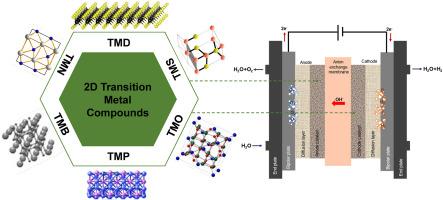纳米结构过渡金属基电催化剂:阴离子交换膜水电解的一种有前景的途径
IF 7.9
3区 材料科学
Q1 GREEN & SUSTAINABLE SCIENCE & TECHNOLOGY
引用次数: 0
摘要
阴离子交换膜电解(AEMWE)是一种可持续生产氢气(H2)的可行技术。传统的贵金属催化剂,如铂和铱,价格昂贵,这阻碍了它们的商业可行性。本文综述了纳米结构过渡金属基化合物(TMCs)作为非贵金属电催化剂的潜力,如过渡金属二硫族化合物(TMD)、过渡金属硫化物(TMS)、过渡金属氧化物(TMO)和其他过渡金属化合物在AEMWE中的应用,重点介绍了它们在析氢反应(HER)和析氧反应(OER)中的优势性能。它还讨论了与实现相关的挑战和机遇,包括稳定性和持久性问题、大规模传输限制和可伸缩性问题。通过对用于AEMWE的纳米结构tmc的最新进展进行全面概述,本综述旨在刺激进一步的研究和开发计划,以实现这种不依赖贵金属的可持续能源技术的商业化。本文章由计算机程序翻译,如有差异,请以英文原文为准。

Nanostructured transition metal-based electrocatalysts: A promising pathway in anion exchange membrane water electrolysis
Anion exchange membrane water electrolysis (AEMWE) represents a viable technology for the sustainable production of hydrogen (H2). Traditional noble metal catalysts, such as platinum and iridium, are costly, which impedes their commercial viability. This review explores the potential of nanostructured transition metal-based compounds (TMCs) as non-noble metal electrocatalysts such as transition metal dichalcogenides (TMD), transition metal sulfides (TMS), transition metal oxides (TMO), and other transition metal compounds for AEMWE, highlighting their advantageous properties for the H2 evolution reaction (HER) and oxygen evolution reaction (OER). It also discusses the challenges and opportunities related to implementation, including stability and durability issues, mass transport limitations, and scalability concerns. By providing a comprehensive overview of the recent progress in nanostructured TMCs for AEMWE, this review aims to stimulate further research and development initiatives to achieve the commercialization of this sustainable energy technology without relying on precious metals.
求助全文
通过发布文献求助,成功后即可免费获取论文全文。
去求助
来源期刊

Materials Today Sustainability
Multiple-
CiteScore
5.80
自引率
6.40%
发文量
174
审稿时长
32 days
期刊介绍:
Materials Today Sustainability is a multi-disciplinary journal covering all aspects of sustainability through materials science.
With a rapidly increasing population with growing demands, materials science has emerged as a critical discipline toward protecting of the environment and ensuring the long term survival of future generations.
 求助内容:
求助内容: 应助结果提醒方式:
应助结果提醒方式:


